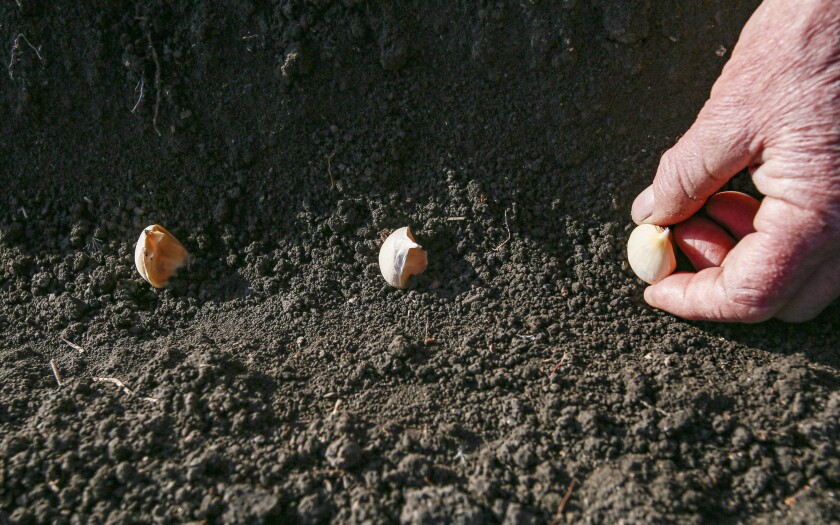Lean closer and I’ll tell you a secret: I’ve never grown garlic. Never one to pass up a new planting adventure, I’ve got garlic bulbs ready for fall planting.
I learned much about vegetable gardening from my mom, yet we never planted garlic. We were a German household, and Mom never cooked much with fresh garlic. My wife, Mary, jokes that to us Germans, cooking with herbs and spices means having onions in the hotdish. And Mary’s half-Norwegian heritage isn’t much better, as a well-spiced dish means salt on the mashed potatoes. All in good humor, of course.
ADVERTISEMENT
Fall is the time to plant garlic. The cloves, which are the sections into which the garlic bulb is divided, are best planted soon after the first hard frost, around late September or early October. Latent heat in the soil prompts the cloves to form roots and underground shoots this fall, which will emerge next spring.

Garlic for planting can be found at garden centers, or from mail-order companies. There are two categories of garlic, called hardneck and softneck. Hardneck types are hardiest and most suitable for northern gardens. "Music" is the most popular variety grown in the region, along with "German Red" and "Spanish Roja." Grocery store garlic doesn’t perform as well for garden planting.
Here are some tips for planting garlic:
- The cloves grow best in a rich, well-drained soil. Add several inches of compost to the soil and work in.
- Good fertility is a must. Add 2 to 3 pounds of 10–10–10 granular fertilizer per 100 square feet, and work into the soil.
- Separate the bulbs into individual cloves the day before planting. Set cloves upright in the furrow, pointed end up, 4 to 6 inches apart and 2 inches deep. Space rows 18 to 30 inches apart.

ADVERTISEMENT
- Water deeply to activate the cloves.
- Mulch with 5 inches of straw, hay or leaves, to insulate the soil and protect the sprouted bulbs over winter from extreme cold temperatures and prevent freezing and thawing.
- Remove protective mulch in late March or early April, before sprouts begin growing.
- Weeds are a major enemy of garlic, because the sparse foliage of garlic doesn’t provide much competition for emerging weeds. Weed by hand beginning early in the season for maximum bulb production.
- Water carefully during the growing season. Garlic grows best in moist, but not wet, soil. Garlic produces better bulbs with optimum moisture, but bulbs will rot if soil is kept too wet, and bulbs won’t achieve best size if soil is too dry.
- If you’ve been successful growing onions, similar techniques will produce good garlic.
- As the garlic is growing, the flower buds, called scapes, can be harvested when they curl in June. Scapes are mild in flavor and great in recipes and stir fries.
- Harvest the bulbs in July or August when foliage turns yellow and lower leaves are brown.
- Instead of harvesting by pulling the bulbs, gently dig, which causes less damage to bulbs and stems.
- The tops don’t need to be completely dry before harvest, because if the bulbs are left in the ground too long and fall rains begin, bulbs can rot.
- After digging, place bulbs, tops and all, on a screen or other mesh in a well-ventilated spot at room temperature for two weeks of curing.
- Remove tops from the bulbs, leaving about 1 inch, after leaves turn brown.
- If stored at room temperature, garlic will remain in good condition for one to two months. For long-term storage up to nine months, garlic is best maintained at 32 degrees with low relative humidity. Good airflow is necessary to prevent any moisture accumulation.
- Your own stored garlic cloves can be used for next fall’s planting. According to the University of Massachusetts, garlic bulbs saved for planting the next years’ crop should be stored at 50 degrees. Storage below 40 degrees results in poor future bulbs, while storage above 65 degrees results in delayed sprouting and late maturity.
- For additional garlic growing tips and recipes, North Dakota State University Extension’s bulletin “From Garden to Table: Garlic” can be accessed at https://www.ag.ndsu.edu/publications/food-nutrition/from-garden-to-table-garlic/h-1409-from-garden-to-table-garlic.pdf.
Don Kinzler, a lifelong gardener, is the horticulturist with North Dakota State University Extension for Cass County. Readers can reach him at donald.kinzler@ndsu.edu or call 701-241-5707.










